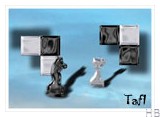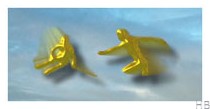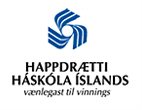Question
What kinds of sports did the Vikings go in for, and what was their attitude towards the body?
Asked By
Sigrún Hólm
Answer
The men of the ancient North viewed 'sports' (íþróttir) in a broader context than we do today; to them the concept took in a wide range of skilled activities to be cultivated and perfected, including crafts, the arts, the ability to compose and interpret verses, games, legal knowledge and book learning. These accomplishments were highly regarded and there seems to have been a tendency to associate them with the higher levels of society, since activities such as trade and farming do not appear to have carried the same kind of status. The account in Snorri Sturluson's Edda of the god Thor's journey to the home of the giant Útgarða-Loki describes sports such as eating and drinking competitions, footraces and wrestling. Verses ascribed to Rögnvaldr kali, earl of Orkney, and King Haraldr harðráði list among their accomplishments skills such as equestrianism, swimming, poetry, chess (or some board game of this type), runes, literacy and general knowledge, craftsmanship, skiing, oarsmanship and harp playing, and there is a famous account in the Saga of the Sons of Magnús Bareleg in Snorri's Heimskringla of a formal debate weighing up the respective merits of the Norwegian kings Eysteinn and Sigurðr in which they boast of their prowess in 'sports' such as wrestling, swimming, skating, archery, skiing, legal chicanery and rhetoric.
The same saga tells of the reception accorded to a subsequent king, Haraldr gilli, when he first arrived in Norway from the Hebrides as a young man. Haraldr brought with him various Gaelic customs that the Norwegians found outlandish: he wore
The account in Snorri Sturluson's Edda of the god Thor's journey to the home of the giant Útgarða-Loki describes sports such as eating and drinking competitions, footraces and wrestling. Verses ascribed to Rögnvaldr kali, earl of Orkney, and King Haraldr harðráði list among their accomplishments skills such as equestrianism, swimming, poetry, chess (or some board game of this type), runes, literacy and general knowledge, craftsmanship, skiing, oarsmanship and harp playing, and there is a famous account in the Saga of the Sons of Magnús Bareleg in Snorri's Heimskringla of a formal debate weighing up the respective merits of the Norwegian kings Eysteinn and Sigurðr in which they boast of their prowess in 'sports' such as wrestling, swimming, skating, archery, skiing, legal chicanery and rhetoric.
The same saga tells of the reception accorded to a subsequent king, Haraldr gilli, when he first arrived in Norway from the Hebrides as a young man. Haraldr brought with him various Gaelic customs that the Norwegians found outlandish: he wore a very Irish costume, short in its cut, and went about lightly dressed. He had trouble speaking Norwegian; the words came haltingly and many people poked fun at him for this.Haraldr, however, managed to prove himself by his sporting skill by making a bet with the royal prince Magnús that he could run faster than Magnús could ride his horse. A course was marked out and Haraldr won, and when King Sigurður heard about this he rebuked his son in these words:
You call Haraldr ignorant but I think you're a fool. You know nothing about how people are in other countries. You never realised before that foreigners cultivate skills other than boozing or getting themselves mad or incapable and then not knowing who's who.According to his saga, King Ólafr Tryggvason was 'the greatest sportsman in Norway', a skilled rock-climber, and
he could walk along the oars sticking out from the side of his ship while his men rowed, and juggle three knives, keeping one in the air at all times, and always manage to catch the handle. He could wield his sword equally with either hand and shoot two spears at the same time.Ólafr was thus clearly in the same league as the Icelandic hero Gunnarr of Hlíðarendi, who, according to Njál's saga, was similarly skilled in arms, had no equal in archery, could jump both high and long when fully armed and armoured, could swim like a seal, and 'it was pointless anyone trying to take him on, whatever game it was'.
 The sagas contain several references to ball games. These were played both on ice and flat fields with a stick and ball and seem to have been rather like the hurling and shinty still played in Ireland and Scotland. There are well-known accounts of such games in Gísli's saga and Egil's saga where the competition becomes so fierce that it ends in bloodshed. In the sagas, as in modern usage, the ideas of sports, games and play are interconnected, since the same word, leikr, i.e. 'play', is applied both to competitive activities and to some kind of play-acting or dramatic activity. As well as things like board games and wrestling, people plainly enjoyed games involving the trading of insults and a boisterous kind of piggy-in-the-middle.
About attitudes to the body in general it is difficult to say anything with any certainty, since the written sagas are coloured by the pervasive influence of neoplatonic ideas on the human body that came in in the 12th and 13th centuries. Even so, it seems clear that physical beauty was greatly admired, then just as now, as, for instance, in this verse from one of the Edda poems, the second Lay of Helgi Hundingsbani:
The sagas contain several references to ball games. These were played both on ice and flat fields with a stick and ball and seem to have been rather like the hurling and shinty still played in Ireland and Scotland. There are well-known accounts of such games in Gísli's saga and Egil's saga where the competition becomes so fierce that it ends in bloodshed. In the sagas, as in modern usage, the ideas of sports, games and play are interconnected, since the same word, leikr, i.e. 'play', is applied both to competitive activities and to some kind of play-acting or dramatic activity. As well as things like board games and wrestling, people plainly enjoyed games involving the trading of insults and a boisterous kind of piggy-in-the-middle.
About attitudes to the body in general it is difficult to say anything with any certainty, since the written sagas are coloured by the pervasive influence of neoplatonic ideas on the human body that came in in the 12th and 13th centuries. Even so, it seems clear that physical beauty was greatly admired, then just as now, as, for instance, in this verse from one of the Edda poems, the second Lay of Helgi Hundingsbani:Helgi stood out high above princes as the all-imperious ash above bramble or the deer buck dew besprinkled that overshines all other beasts, with horns that glow against the heavens.The fullest treatment of sports and games in the ancient North is Björn Bjarnason's Íþróttir fornmanna á Norðurlöndum. Þorsteinn Einarsson has written widely on the history of sport in Iceland, especially winter sports and glíma (Icelandic wrestling), which he connects with similar types of wrestling among the Gaelic peoples. Pictures: HB
Um þessa spurningu
Dagsetning
Published 5.3.2005
Category:
Citation
Gísli Sigurðsson. „What kinds of sports did the Vikings go in for, and what was their attitude towards the body?“. The Icelandic Web of Science 5.3.2005. http://why.is/svar.php?id=4801. (Skoðað 7.1.2026).
Author
Gísli Sigurðssonrannsóknarprófessor á Stofnun Árna Magnússonar í íslenskum fræðum



